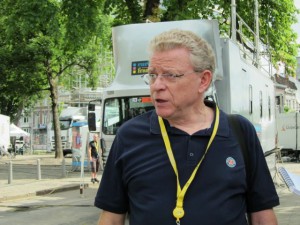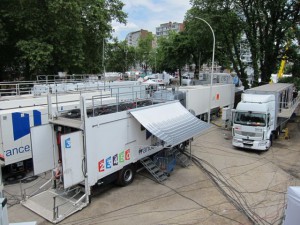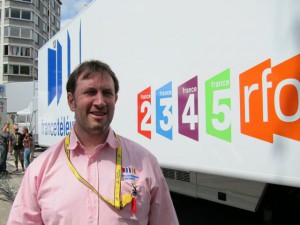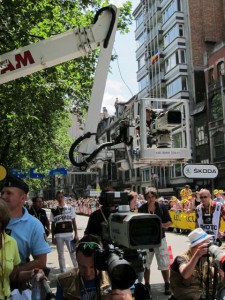Live from the Tour de France: MPEG4 gives improved look to coverage

Luc Geoffrey, Euro Media Group, CTO, says the Tour de France this year will make use of MPEG4 technology.
This past weekend arguably the greatest show in broadcasting, the Tour de France, took to the streets of Liege in Brussels for the prologue of a race that will conclude on July 22 in Paris after covering more than 3,497 kilometres. And while the course may change every year the challenge for France Televisions and Euro Media Group, the two companies at the center of the host broadcast feed production and the feed for French viewers, is the same: set up, strike, and move a sport production 20 times in 22 days.
“It’s a circus,” says Luc Geoffrey, Euro Media Group, CTO.
In fact, it is such a large circus, and with personnel dedicated to specific parts of the course (start of the race, course coverage, end of the race) that they often never meet each other because once one stage ends it is off to the next.
The compound itself reflects the circus-like atmosphere. During the remainder of the race the dozens of vehicles (not only the production trailers but the portable sets, generators, support vehicles, catering, and more) will be in a wide variety of locations with widely different spacing constraints. The distance between trucks can be up to one kilometer, requiring a fibre infrastructure.
“And sometimes the compound is split by more that 100 meters,” adds Geoffrey.
The core of the race coverage is the use of five high-frequency wireless cameras on motorbikes, two journalists reporting from motorbikes, and images captured from two helicopters with Wescam gyro-stabilised camera systems. The five cameras capture the
drama and beauty of the race from within it while the helicopters cover the race and also captured much of the beauty of the French countryside that is such a large part of the production. At the finish line nine additional cameras area in place to capture the dramatic reactions of racers finishing stages and during time trial stages, like the prologue on Saturday, hard-wired cameras are placed on the course. Also new this year is a camera mounted on the Tour de France race director’s car.
The transmission challenge
Keeping up with the racers is only part of the challenge, as the producer and director communicate with drivers and cameramen to position the bikes in the right spot relative to racers. The other? Ensuring that the camera signals get back to the broadcast compound, located at the finish line. New this year is the use of MPEG4 for backhaul transmission of signals from the field.
“We save bandwidth and can increase the quality,” says Geoffrey.
The key to getting the signals back to the compound are the use of two airplanes, one flying at a low level and one at a higher level, a helicopter, and transmission vehicles from French service provider Broadcast that are placed at intermediate points along the course. As many as three intermediate points have been used in the past but this year’s coverage will typically rely on two.
“Sometimes the distance between the plane and the truck can be 100 kilometers and we have seven transmitters on the plane so there is a lot of coordination,” says Geoffrey. “We also have a very directional antenna on the plane and truck.”
Camera signals bounce via satellite and high-frequency wireless between the ground and the aerial vehicles. Given the length of the race weather will invariably become an issue and it can impact aerial coverage as well as transmission plans. The helicopters are core to the coverage as they can fly at slower speeds and hover over race leaders and also maintain a constant shot from above.
“It’s easy for the helicopter to follow the position of the bike, especially in a city with small roads and high buildings,” adds Geoffrey. “That gives the helicopter a groove it has to fly over.”
If the weather turns too bad then the use of the plane flying above the clouds becomes integral to the broadcast.
“If they fly very high we have a GPS system on each bike and the camera’s receive the GPS signal to help define a position,” explains Geoffrey. “And the pilot can be told to fly above bike number five and he can find it.”
The production
Samuel Alegre, France Télévisions, video technician, overseas the network’s fleet. “The challenge is to follow the race but also show France,” he says, which is one of the reasons the main production area has a dual vision mixer set up with one dedicated to the host broadcast feed and a second, located behind it, that is used to mix the French coverage.
“Jean Maurice, the director, directs things a little differently for the French as it is usually more focused on the culture and heritage,” adds Alegre.
A key component in the OB units are the EVS servers which include XT servers and Multicam LSM for the live production, an XT server and IP Director for browsing and on-the-fly editing, and an XT server for playout.
Another OB unit from Euro Media is used for post-production needs, with three Avid Media Composers located in the truck. And then there are additional OB units from broadcasters like ITV, NBC Sports, and more. An EVS XTAccess system transfers media to the Avid and also transcodes additional footage gathered via ENG.
One possible change in the future for the EVS system is that there are more and more requests from broadcasters to have access to more material. That may lead to a centralised server approach but even that has its risks as if that OB unit gets stuck somewhere due to traffic or an accident it would adversely impact the entire production.
But for now the workflow is working just fine. The weather has cooperated. And the racers are off. For the 4,500 people who are moving from one of the 37 cities and towns to the next the circus has begun.



